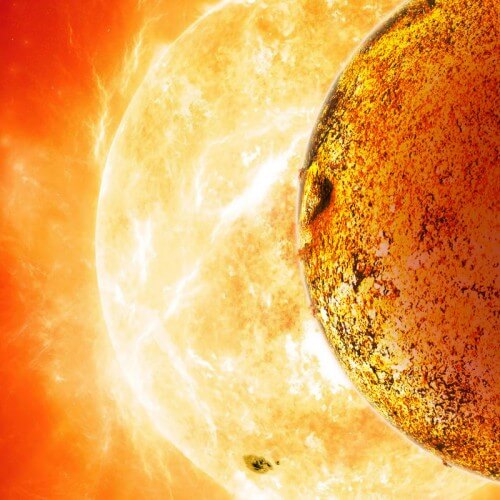Kepler b78 consists mainly of rocks and iron, just like the Earth, but it is very close to its Sun - only one percent of the distance between the Earth and the Sun, so it is very hot and its rocks are actually boiling lava

With the announcement of the termination of the Kepler space telescope, NASA noted that it left over two thousand candidates for planets, which still need to be examined by ground-based and other telescopes to confirm their existence.
One of them, Kepler 78b is an Earth-sized planet orbiting a star similar to our Sun 400 light-years away in the Cygnus group. The observations show that Kepler 78b is composed mainly of rocks and iron, just like the Earth, but it is very close to its Sun - only one percent of the distance between the Earth and the Sun, so it is very hot and its rocks are actually boiling lava, according to studies by two separate teams published in writing Nature magazine.
According to the theory, a planet so close to its sun should be in a tidal relationship with it and show only one side to it. It is estimated that on the day side of the planet, the temperature reaches 2,000-2,800 degrees Celsius. too hot to preserve life. On the day side the ground is also melted. It is difficult to calculate what is happening on the night side of the planet, because the boiling layer is expected to spread and surround the entire planet.
More of the topic in Hayadan:Kepler's discovery tied the record for a star with seven planets
Efforts to repair the Kepler space telescope failed
Kepler discovered two Earth-sized planets
The hot Earth (about the weight of a hot Jupiter - planets the size of Jupiter and more that are very close to their sun) therefore belongs to a new group of short-lived planets that were recently discovered in follow-up studies of Kepler's observations. The duration of its orbit around the central star in the system is expected to be 12 hours.
Like all the other many planets discovered by Kepler, Kepler 78b was also discovered by the transit method, when the light of the planet blocked part of the light of the star as it passed between it and the angle of view of the Earth. Depending on its mass, a planet leaves a gravitational imprint on its star's motion due to Doppler shift. The calculations show that the size of Kepler 78b is 1.2 times that of Earth and its mass is 1.7 times. The density of the planet is 5.3 grams per cubic centimeter, close to the density of the Earth 5.5 grams per cubic centimeter. From this the researchers came to the conclusion about its rocky composition.
According to Dimitri Seslov of the Harvard Smithsonian Center for Astrophysics, one of the authors of the study, Kepler b78 is about to end its life inside its sun. Eventually it will get so close that its sun's gravity will tear it apart, and it will disappear completely within three billion years. He also adds that this planet poses a puzzle to researchers because it is believed that it did not form where it is and it is also very difficult to think of a mechanism that brought it there from somewhere else.
To the announcement of the researchers on the website of the Howard Smithsonian Institution

One response
The earth will also perish in a billion and a half years and some say that when the sun explodes in 5 billion years with the loss of all fuel for combustion not only from me, it will disappear.